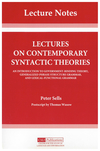An Introduction to Government-Binding Theory, Generalized Phrase Structure Grammar, and Lexical-Functional Grammar
This book rpovides an introduction to three contemporary syntactic theories, Government-Binding Theory, Generalized Phrase Structure Grammar, and Lexical-Functional Grammar. In Successive chapters, Sells lucidly presents and illustrates the fundamental aspects of each theory. In an introductory chapter, he describes the basic syntactic concepts and assumptionsshared by each theory; in the postscript, Thomas Wasow provides a more general overview of the different perspectives of these three approaches.
Peter Sells was a postdoctoral research affiliate at
CSLI when writing this. He is now (2014) Professor and Head of Department of
Language and Linguistic Science at York University.
Translated into Spanish, Japanese, and Korean.
- Author's Preface
- 1 Basic Concepts of Syntax
- 1 Syntactic Competence
- 1.1 Grammaticality
- 1.2 Universal Properties of Language
- 1.3 Data
- 2 Constituency
- 2.1 Tree Diagrams
- 2.2 Labelled Bracketing
- 3 Phrase Structure Rules
- 4 The Lexicon
- 4.1 Lexical Insertion
- 4.2 Subcategorization
- 5 Transformations
- 2 Government-Binding Theory
- 1 X′-Theory
- 1.1 The X′-Scheme
- 1.2 Subcategorization
- 2 The Projection Principle
- 3 θ-Theory
- 3.1 θ-Roles
- 3.2 θ-Criterion
- 4 C-Command and Government
- 5 Move-α
- 5.1 Trace Theory and Empty Categories
- 5.2 Coindexing
- 5.3 Landing Sites
- 5.4 Subjacency
- 6 Case Theory
- 7 Summary of Types of Movement and Complement Structures
- 8 Empty Category Principle (ECP)
- 9 Ginding and NP-types
- 9.1 Binding Theory and the Typology of Empty Categories
- 9.2 Control
- 3 Generalized Phrase Structure Grammar
- 1 Features and Syntactic Categories
- 1.1 X′-Theory
- 1.2 Categories
- 1.3 Features
- 2 ID/LP Format
- 2.1 ID/LP
- 2.2 Heads and Subcategorization
- 3 Rules
- 3.1 Lexical and Non-Lexical ID-Rules
- 3.2 Metarules
- 4 Sketch of Semantics
- 5 Projecting From Rules to Trees
- 5.1 Feature Cooccurrence Restrictions
- 5.2 Feature Specification Defaults
- 5.3 Head Feature Convention
- 5.4 Foot Feature Principle
- 5.5 Control Agreement Principle
- 5.6 Linear Precedence Statements
- 6 Unbounded Dependencies and Coordination
- 6.1 Unbounded Dependencies
- 6.2 Coordinate Structures
- 4 Lexical-Functional Grammar
- 1 Constiuent Structures
- 1.1 Phrase Structure
- 1.2 Funtional Annotations
- 2 Functional Structures
- 2.1 Properties of F-Structure
- 2.2 Well-Formedness Conditions on F-Structures
- 2.3 From C-Structuresto F-Structures
- 3 The Lexicon
- 3.1 Types of Grammatical Function
- 3.2 Subcategorization
- 3.3 Some Sample Lexical Entries
- 3.4 Lexical Rules
- 4 Control Binding
- 4.1 Functional Control
- 4.2 Anaphoric Control
- 4.3 Anaphoric Binding
- 5 Long-Distance Dependencies and Coordination
- 5.1 Long-Distance Dependencies
- 5.2 Coordination
- 5 Postscript by Thomas Wasow
- List of Abbreviations
- References
- Index of Names
- Index of Subjects
1/1/1985


